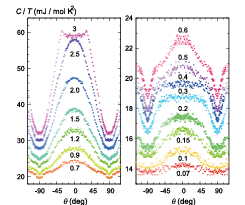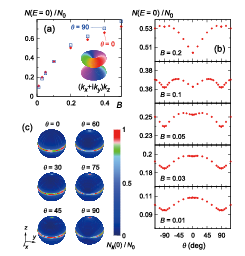Probing a Horizontal Line Node in the Heavy-Fermion Superconductor URu2Si2 by Angle-Resolved Heat Capacity Measurements
Sakakibara Group
Identification of the gap structure of anisotropic superconductors (SCs) has been the subject of intensive study over many years. Among various experimental techniques, the heat capacity (Cϕ) measurement in a rotating magnetic field (H) is quite useful because of its wide applicability. This technique is based on the fact that the field-induced zero-energy density of states, N(E=0), in the superconducting mixed state of a nodal SC is field and its orientation dependent. In the case of a tetragonal SC with vertical line nodes, in particular, Cϕ shows an angular oscillation when H is rotated in the basal plane, with Cϕ minima occurring along the nodal directions.

Fig. 1. Polar angle dependence of C/T of URu2Si2 measured at 0.2 K in various magnetic fields ranging from 0.07 to 3 T.

Fig. 2. (a) Field dependence of N(E=0) for B||z and B||x, obtained by microscopic calculations assuming the kz(kx+iky) gap. (b) Calculated polar angle variation of N(E=0) at several fields. (c) Angle-resolved density of states, Nk(0), mapped on the spherical Fermi surface. The magnetic field is rotated in the xz plane.
To probe the horizontal line node, however, is not so easy. When H is rotated in the ac plane of the tetragonal crystal, the polar angle (θ) variation of the heat capacity Cϕ(H) is expected to exhibit a twofold oscillation reflecting the gap structure. It should be reminded, however, that because of the tetragonal symmetry of the lattice, the upper critical field Hc2 would have a substantial twofold anisotropy in the ac plane and give rise to a strong twofold background in Cϕ(H). Hence, the simple argument—the direction of minima in Cϕ(H) corresponds to the nodal direction—does not hold.
Nevertheless, because the θ variation of the field-induced N(E=0) would exhibit local minima as the direction of H passes through the horizontal line node, fine structures may appear in the twofold oscillation of Cϕ(H). We applied this technique to the heavy fermion superconductor URu2Si2 [1], whose gap structure is suggested by previous experiments to be a chiral d-wave, kz(kx+iky), having a horizontal line node and polar point nodes [2,3].
Figure 1 shows the measured results of Cθ(H) obtained by rotating H within the ac plane. At high fields, the large twofold oscillation is observed, reflecting the anisotropy of Hc2 predominantly due to the anisotropic Pauli paramagnetic effect. In the low-field region below 0.15 T, no remarkable anomaly was detected in C(θ): the data can be fitted by a simple twofold function expected for an effective mass model. By contrast, a striking feature is found in C(θ) in the region 0.2~1.5 T; a shoulder-like anomaly appears at around θ~45º. With increasing H, this anomaly slightly moves to the higher θ side.
We calculate the θ dependence of the N(E=0) on the basis of the microscopic Eilenberger theory assuming the gap symmetry of kz(kx+iky) [inset of Fig. 2(a)] and a single-band spherical Fermi surface. For simplicity, the Pauli-paramagnetic effect and the anisotropy of the Fermi velocity are not taken into account. Figure 2(a) shows the field dependence of N(E=0) at θ=0 (H||z) and 90º. For both field directions, H1/2 dependence is obtained reflecting the line node. Note that a small anisotropy appears in N(E=0).
In Fig. 2(b), N(E=0) is plotted as a function of θ at several fields. The calculated result at a low field B=0.03 can reproduce the features observed in the present experiment, i.e. the shoulder-like anomaly and the dip structure in C(θ) observed at moderate fields. With increasing B, a sharp dip develops at θ=0 and then the anisotropy in N(E=0) is reversed above B∼0.1, reflecting the Hc2 anisotropy. The dip at θ=0 and the reversal of the C(θ) anisotropy in the high-field region, demonstrated in Fig. 2(b), were not detected in the experiment because the actual Hc2 anisotropy depends on the strong Pauli-paramagnetic effect. Figure 2(c) shows the momentum-resolved density of states, Nk(0), mapped on the spherical Fermi surface. The field B=0.03 is rotated in the xz plane. When B||z (θ=0), strong quasiparticle excitations occur on the line node as indicated by a red color. As B rotates towards x direction, the quasiparticle excitations at the region ky=0 are strongly reduced, resulting in a decrease in N(E=0). This effects account the shoulder-like feature in C(θ) near 45º.
The present results indicate that a horizontal line node exists in URu2Si2. Note that among the possible gap structures for a tetragonal even parity SC, only kz(kx+iky) has the horizontal line node. Thus, the pairing symmetry of URu2Si2 is likely to be the chiral d wave [1].
References
- [1] S. Kittaka et al., J. Phys. Soc. Jpn. 85, 033704 (2016).
- [2] Y. Kasahara, T. Iwasawa, H. Shishido, T. Shibauchi, K. Behnia, Y. Haga, T. D. Matsuda, Y. Onuki, M. Siglist, and Y. Matsuda, Phys. Rev. Lett. 99, 116402 (2007).
- [3] K. Yano, T. Sakakibara, T. Tayama, M. Yokoyama, H. Amitsuka, Y. Homma, P. Miranović, M. Ichioka, Y. Tsutsumi, and K. Machida, Phys. Rev. Lett. 100, 017004 (2008).
